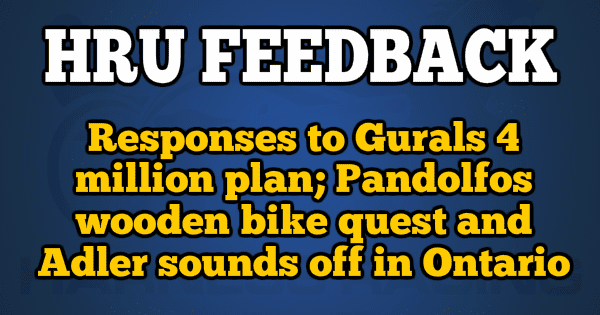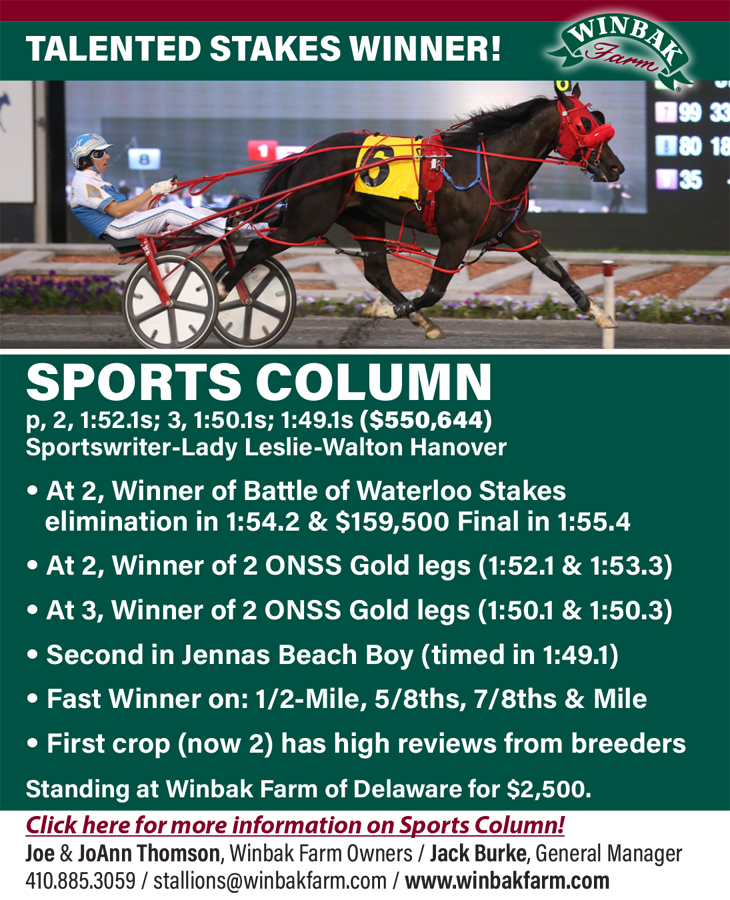
HRU Feedback (2018-05-06)
Trond Smedshammer on Big M stakes totals
(RE: Between The Lines)
Hello HRU ! I understand Gural’s frustration, but could you please ask him to show a breakdown of how he comes up with $4 million that he could move from stakes to overnight purses. I’m not saying it’s not possible, but I would like to see what those stakes are, I always thought stake races was fairly cheap to run since we race mostly for our own money.
— Trond Smedshammer / Allentown, NJ
Editor’s note: HRU contacted Jeff Gural with Trond Smedshammer’s question and received a breakdown chart showing all stakes and a total of more than $4.76 million spent on stakes at the track. The entire chart is too big to publish here, but HRU checked the totals and the summary is as follows, with the missing column headings (from left to right): 2017 Purse, N/S Fees, Entry Fee and Added Actual
Gural responds further to Sturman column
(RE: Between The Lines)
I did receive some feedback from Brett’s story about the Meadowlands stakes season being in jeopardy next year and I wanted to make it very clear that I am doing everything possible to convince the state to restore the $30 million subsidy that horse racing in NJ was receiving. The Governor was at the Meadowlands on Friday attending a major fundraiser for Senator Menendez and I spoke to him about the situation and both Mike Gulotta and I are planning to attend a State Democratic fundraiser at his home on May 14, and together with the thoroughbreds and the SBOANJ we have retained two prominent lobbyists to help us in our efforts to convince the legislature of the economic benefits of horse racing to the State of NJ. We will know the results of our efforts by June 30, when the legislature recesses and the budget is finalized. If anybody has political connections in the NJ legislature it certainly would not hurt to make them aware of the importance of the Meadowlands and horse racing in general.
On a separate subject, while it is true we would certainly have more horses if we allowed certain trainers to race who are currently excluded on the theory we could catch them, the reality is it is very hard to catch trainers who are using illegal substances and we are already spending $300,000 per year on this effort. Just remember how hard it was to actually catch Lance Armstrong and in fact he never did fail a drug test. The bad guys are simply ahead of the testing labs. Hopefully that will change as we continue to do more out of competition testing.
Keep in mind, I own two breeding farms, 40 broodmares and all or part of over 40 two and three year olds and I am very much looking forward to the upcoming stakes season. Cancelling the stakes would be devastating to me personally. I also want to add without all the sponsorships we have received from the industry we would have had to cut the stakes schedule last year so thanks to all our sponsors.
— Jeff Gural / chairman Meadowlands Racetrack
Further to story on small tracks not signing Ontario’s long-term funding deal
It has been reported on Standardbred Canada that Ontario Minister of Finance, Charles Sousa, says that rural Ontario will be represented on the new Ontario Racing board of directors. Don’t know if SC will print my condensed response, but here is the longer version. Mr. Sousa is a little naïve in thinking rural Ontario will be represented (Windsor is included). What rural Ontario needs is “STRONG” representation on the new Ontario Racing board, which I have dubbed OR.3! The current candidate board members are tilted in favor of WEG (Woodbine Entertainment Group), and the projected “rural” board members are all tied to WEG. I’ll even name names: Grand River in Elora has just hired Jamie Martin, who just left his six-figure job at WEG; Western Fair in London’s top exec is Hugh Mitchell, another WEG import, as well as former WEG personality Greg Blanchard, who is now manager at WFR. Blanchard was also hired on by Dresden as their manager, and word comes that Dresden signed last week after being pressured by Cal Bricker of the OLG. Next is Ian Fleming, a powerful manager at Clinton Raceway who also serves as the racing secretary for many of the rural tracks. Heather McKay just left Kawartha Downs (Peterborough) and is a member of OR.
Combine these “rural” reps with the fact that the projected balance of the new OR.3 will include many from the old OR, OHRIA, COSA, many of whom are the same WEG people. Only the name has changed.
Don’t get me wrong, these are all good people with strong racing backgrounds, but I beg to be disproved if they all don’t have strong ties to WEG.
So, Mr. Sousa, will OR.3 have strong “rural” representation? That is one of the reasons why Leamington Horse Racing Association said “No” at this time.
— Marty Adler / Amhertsburg, ON
RE: Wooden bikes
RE: Guest Column
I for one would love to see the game go back to the wooden bikes for all the reasons Bob Pandolfo and Ron Pierce pointed out. But here is something else to think about, and that is these new speed bikes and the amount or type of pre-race that many of the trainers are using I believe using the wooden bikes we would not see the vast improvement in performance we see now. We see horses claimed from 12-15’s that finished out of the money claimed and step up next race and go gate-to-wire and set a better time than the winner a week prior. Racing today with pre-race and the speed bikes goes against all logic. How is it possible to leave hard and make every quarter a winning quarter and then as the field starts to swarm this leader the horse re-breaks and goes on to win by open lengths? With the larger and slower wooden bike, the driver would now have to put himself in a position to win not just gun to the front and hope the horse didn’t decelerate too bad. Someone wrote a while back that acceleration and deceleration in harness racing now with pre-race and the new bikes goes against all logic by ratio and percentages. Maybe if they went back to the wooden bike it would expose those who are cheating but then again maybe those of us who really care about the game are just seeing the game die because we didn’t protect the game and make it better.
— Bob Adams / London, ON
More on wooden bikes — the distance between horses has increased
I just read Bob Pandolfo’s article regarding the use of the modified sulky and the alleged problems caused by them. Although I agree with most of his and Ron Pierce’s opinion, I would like to point out what I believe to be a major issue in this discussion. Over the years, distance between the rump of the horse and the driver’s helmet has increased tremendously. For example, if you look at the older premodified race bikes, the driver could touch the horse’s tail with no problem. Next came the original modified sulky (Nassau, Jerald, etc.) where the driver was a little further from the horse’s rump. Then came the newer type modified sulkies (Evolution, Blackjack, etc.) where the driver is 2-3 feet further from the horse’s rump. When you include the recent advent of drivers leaning back about 2 feet behind the seat, you have increased the distance from the horse’s rump to the driver’s helmet by at least 3.5 to 4 feet. Now, begin the calculation of that added distance to each starter exponentially and you get the horse sitting 8th going an extra 21 to 23 feet further than before. Just that fact, in and of itself, shows why the speed or front forward horses have such an advantage. When the industry looks to solve some of these speed biased issues, I believe this is an important component of the discussion.
— Kim Hankins / Executive Director MSOA, Meadow Lands, PA













